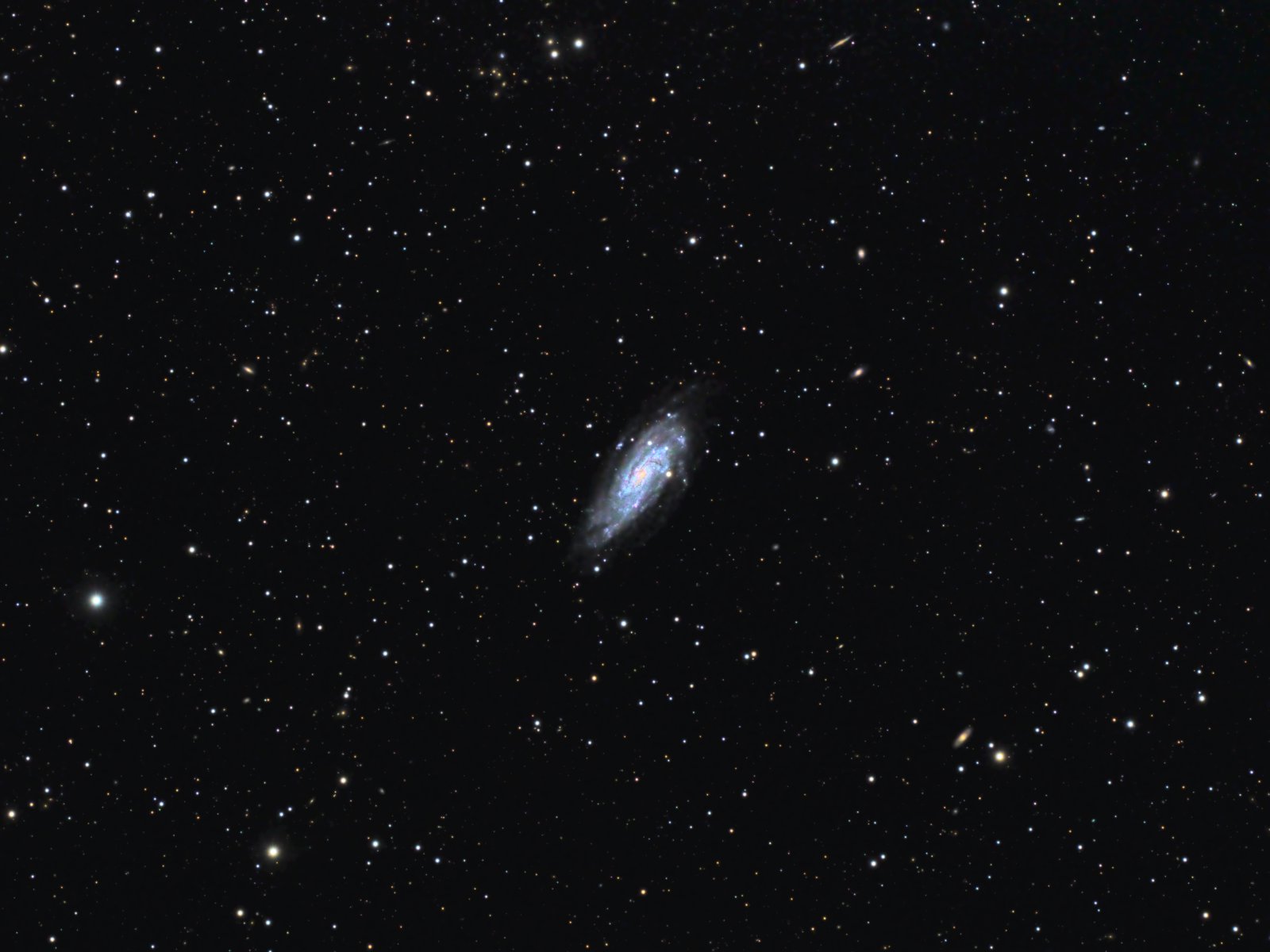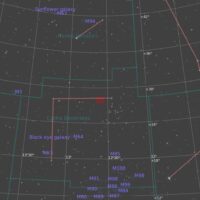NGC 4559
 Click image for full size version
Click image for full size version
May 1, 2022
NGC 4559 is a galaxy in Coma Berenices. It is classified as an intermediate galaxy, being midway between a barred spiral and and regular spiral galaxy. It also has a weak inner ring structure. This galaxy is a member of the Coma I group and lies about 29 million light years away. It seems to not be photographed very often, perhaps because it’s a rather small target with a lot of showpiece galaxies nearby.
Tekkies:
Acquisition, focusing, and control of Paramount MX mount with N.I.N.A., TheSkyX and PHD2. Focus with Optec DirectSync motors and controller. Equipment control with PrimaLuce Labs Eagle 4 Pro computer. All pre-processing and processing in PixInsight. Acquired from my SkyShed in Guelph. Average transparency and seeing. Acquired March 29-April 28, 2022, mostly under a moon-free sky.
Sky-Watcher Esprit 150 f/7 refractor and QHY600M camera with Optolong UV/IR and 3nm H-alpha filters
19x10m Ha = 3hr10m
85x5m OSC = 7hr05m
The WeightedBatchPreProcessing script was used to perform calibration, cosmetic correction, weighting, registration and integration of all frames. DrizzleIntegration was applied to the OSC frames, and the result was aligned to the Luminance master with StarAlignment. This yielded aligned Ha, Lum and Colour masters.
Colour
Linear Noise Reduction: MultiscaleLinearTransform was used to reduce noise in the background areas. Layer settings for threshold and strength: Layer 1: 3.0, 0.5 Layer 2: 2.0, 0.35 Layer 3: 1.0, 0.2 Layer 4: 0.5, 0.1
Stretching: HistogramTransformation was applied to make a pleasing yet bright image.
Luminance
Deconvolution: A star mask was made from the Luminance master to use as a Local Deringing Support Image. A stretched clone of the H-alpha image was used to make a mask selecting bright regions of the nebula for deconvolution. Deconvolution was applied (30 iterations, regularized Richardson-Lucy, ParametricPSF mode with default settings; Global dark deringing = 0.02; Global bright deringing 0.007).
Linear Noise Reduction: MultiscaleLinearTransform was used to reduce noise in the background areas. Layer settings for threshold and strength: Layer 1: 3.0, 0.5 Layer 2: 2.0, 0.35 Layer 3: 1.0, 0.2 Layer 4: 0.5, 0.1
Stretching: HistogramTransformation was applied to make a pleasing yet bright image.
H-alpha
Linear Noise Reduction: MultiscaleLinearTransform was used to reduce noise in the background areas, using an internal mask to protect bright stars. Layer settings for threshold and strength: Layer 1: 5.0 0.75, 1 iteration; Layer 2: 4.0, 0.6, 1 iteration, Layer 3: 3.3 0.5, 1 iteration; Layer 4: 1.0, 0.25, 1 iteration.
Stretching: HistogramTransformation was applied to make a pleasing yet bright image.
Combining Luminance, H-alpha and Colour Images
Luminance addition: LRGBCombination was applied to replace the lightness of the RGB image with the Luminance master.
H-alpha Blending: PixelMath was used to add H-alpha to the LRGB image (the target image, $T), using the following expressions for the R, G and B channels:
R: max($T[0], 1.5*Ha)
G: $T[1]
B: iif($T[0]<Ha, $T[2] + 0.075*Ha, $T[2])
Additional Processing
Star Removal: StarNet v2 was used to remove stars.
Nonlinear Noise Reduction: TGVDenoise was used in L*a*b* mode to reduce noise with a mask used to target the background areas and protect nebula (max. 1,000 iterations and convergence selected for both lightness and chrominance).
Contrast Enhancement: LocalHistogramEqualization was applied using an inverted lightness mask to protect the background and select the nebula. Three passes were applied (scale 20, max contrast 1.5, strength 1.0, 1 iteration; scale 50, max contrast 1.5, strength 0.7, 1 iteration; and scale 100, max contrast 1.5, strength 0.22).
Sharpening: MultiscaleMedianTransform was used to sharpen Layers 2 – 4 with strengths of 0.07, 0.05 and0.03, respectively.
Star Restoration: Stars removed using StarNet2 above were added back into the image using straight addition in PixelMath.
Final Steps: Background, galaxy and star brightness, contrast and saturation were adjusted in several iterations using CurvesTransformation with masks as required. ICCProfileTransformation (sRGB IEC61966-2.1; Relative Colorimetric with black point compensation) was applied prior to saving as a jpg.








Gorgeous image!
Thanks!